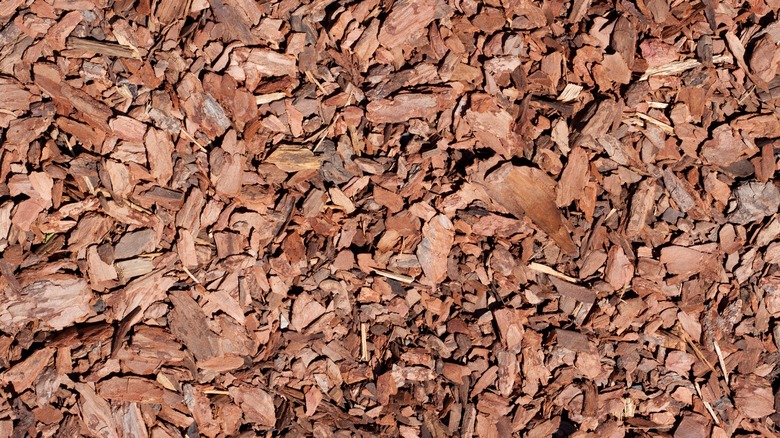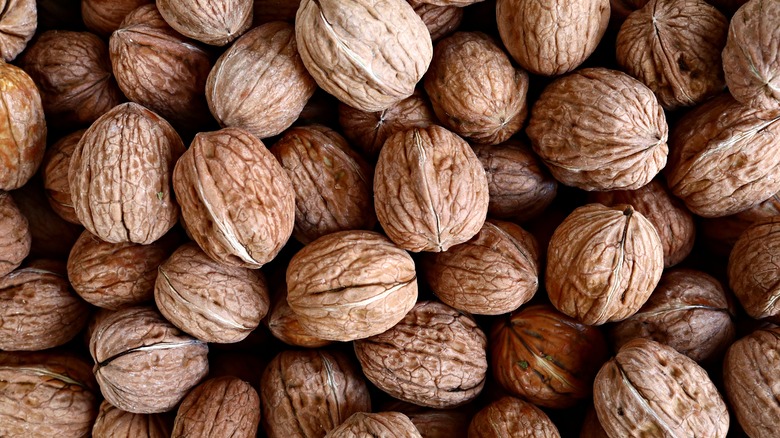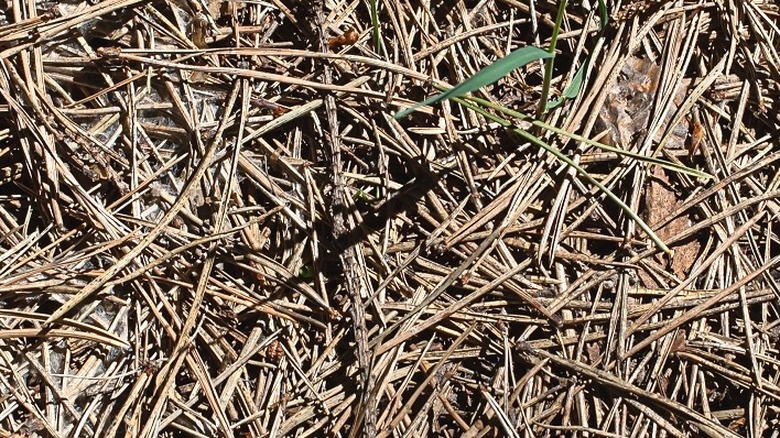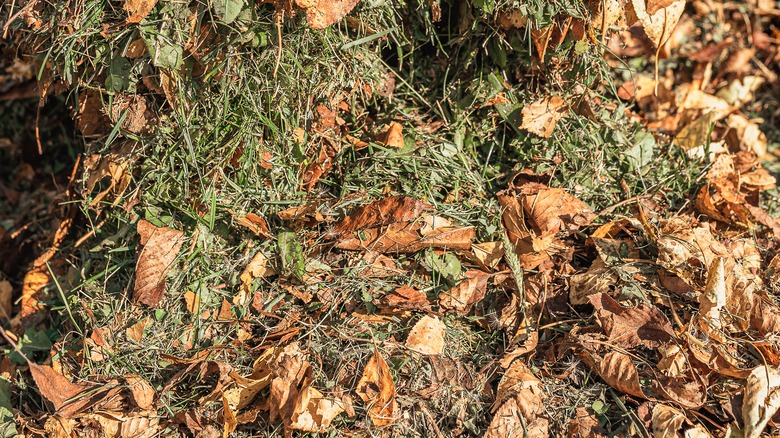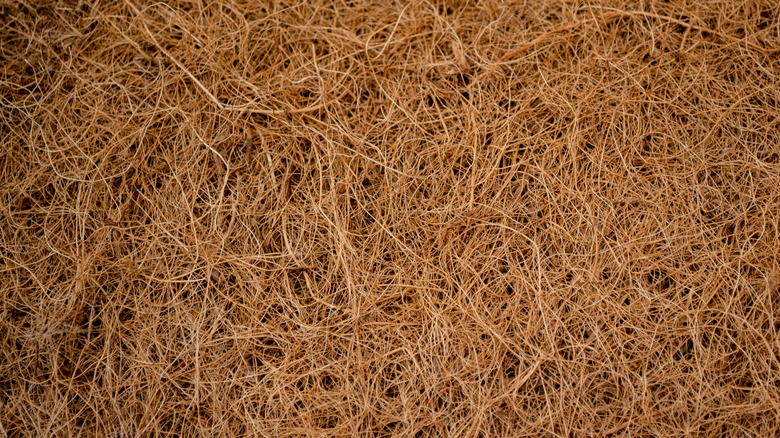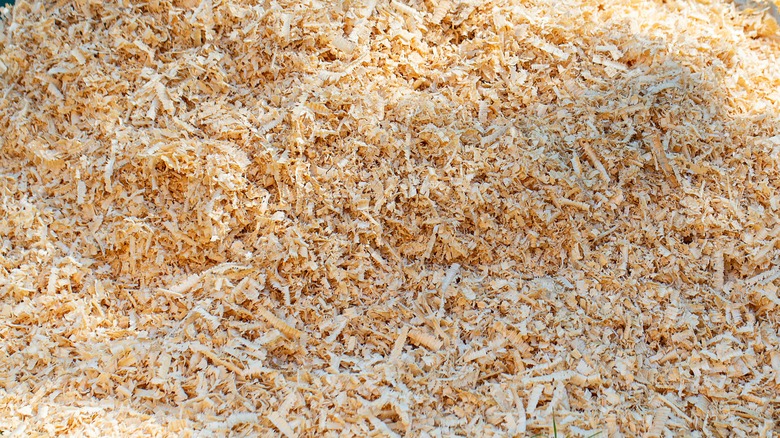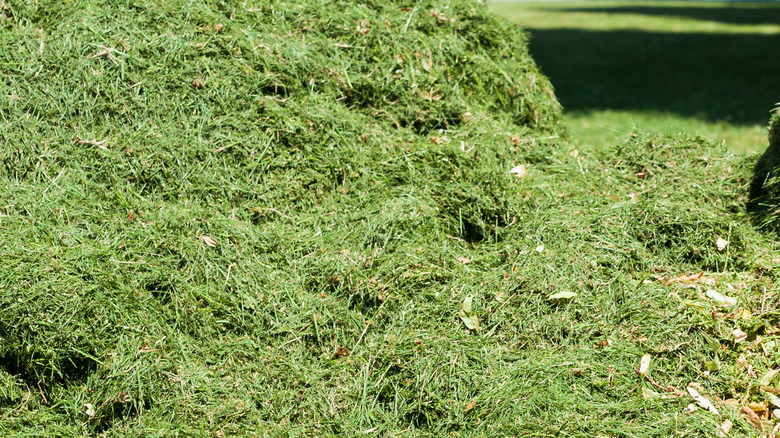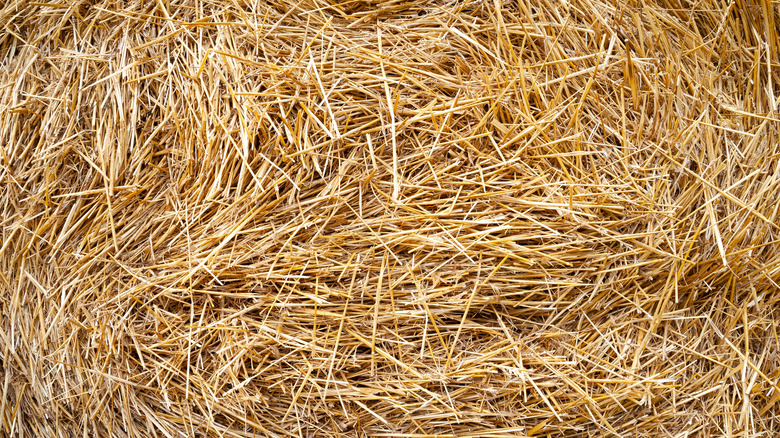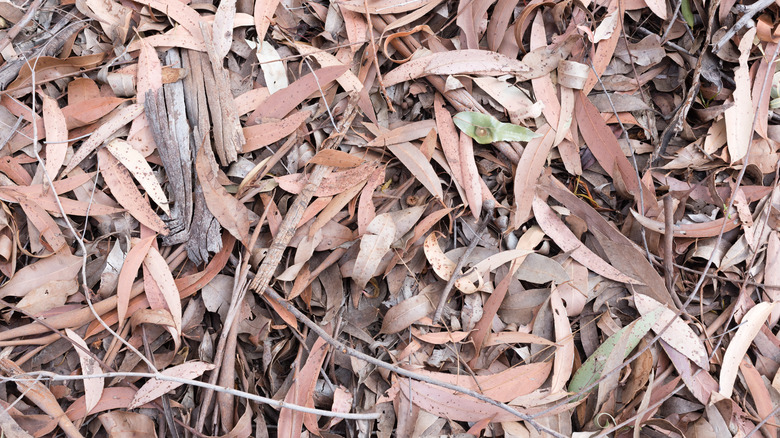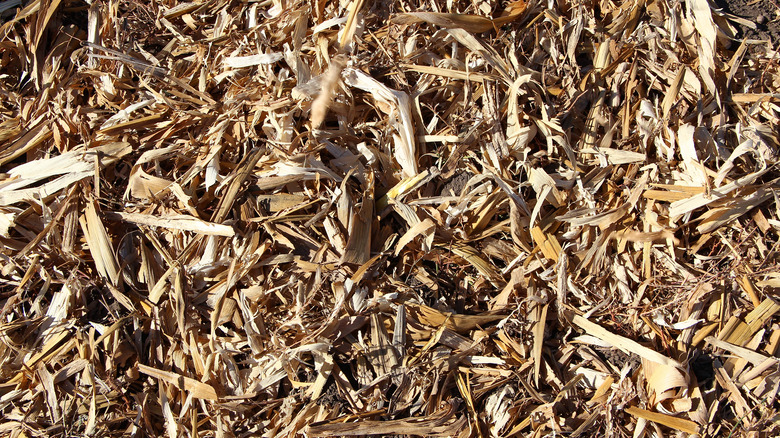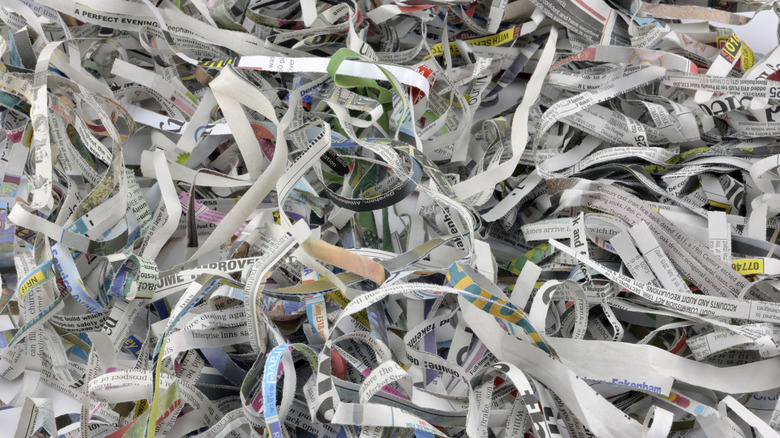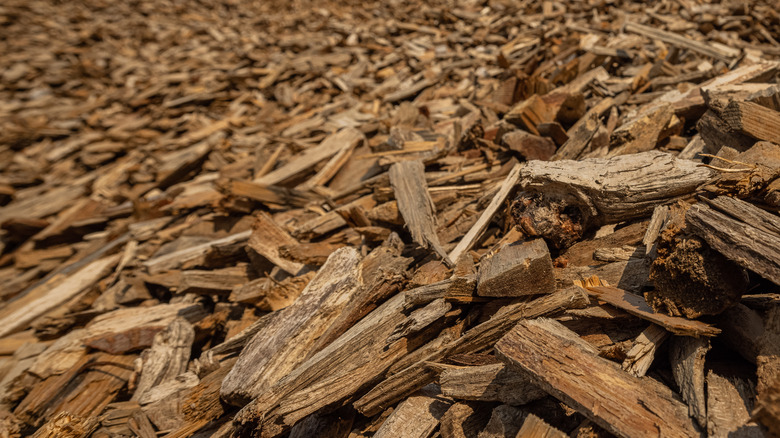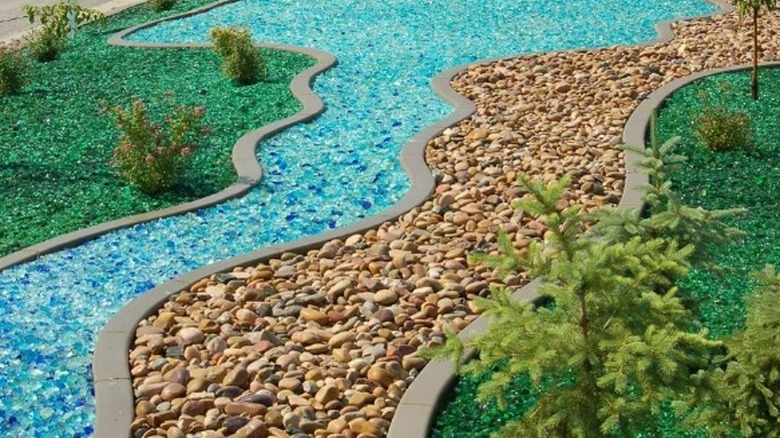12 Eco-Friendly Mulch Options
When it comes to mulch, you want to make sure you're giving your plant life the best of the best, which means, of course, that it should be as earth-friendly as possible. Using the proper mulch can prevent weeds from growing and help regulate soil moisture and temperature. It's also biodegradable, so as it breaks down, it releases beneficial elements into the soil bed, which provides more nutrients for your plants, as per Michigan State University. Because it acts like a protective blanket, good mulch works like a barrier against external forces (like lawnmowers) and can also prevent infectious diseases.
That being said, it's important to remember that not all mulches are created equal. For example, recycled rubber mulch might sound like an ecologically smart option, since it's produced using rubber that would otherwise slowly degrade in a landfill. While it does break down incredibly slowly, it also seeps chemicals and toxins into the earth and is super flammable, per Washington State University's Horticulture Myths.
So what can you use to help protect your garden and the earth, and keep both in tip-top shape? We're so glad you asked because we found 12 of the most ecologically friendly mulch options that you can find year-round.
1. Nut and seed shells
Nut shells decompose slowly and provide a number of benefits to the soil and plants. In order for them to properly work their magic, they need to be crushed and mixed in with other muchly substrates like grass, leaves, or wood chips. Hard nut shells are rich in nutrients like nitrogen, phosphorus, and also carbon, which helps break down organic matter into compost. You can approach it from a "no frills" perspective and just toss them into a compost bin or straight on top of the soil. Pistachio shells work great when used in this application.
2. Pine needles
Pine needles create a nice, thick blanket when used as mulch. They hold onto moisture, keep the soil cool in warm weather, and provide ample protection when the weather gets frosty. Pine needles are also lightweight and breathable, so you won't need to worry too much about mildew growth and lack of airflow. They can also be put through a compost shredder to give them more surface area (and make them less painful to pick up). Pine needles are flammable, so make sure there are no fire pits around.
3. Leaf mulching
Leaves are pretty much free mulch. They provide ample protection for the ground that they cover from the elements and put a stop to any potential soil erosion. When crushed, leaves release their stored carbon, phosphorus, potassium, and nitrogen into the soil, which makes it more fertile. On top of that, mulching leaves makes a great natural habitat for beneficial bugs that normally find safe haven in this type of detritus.
4. Coconut coir
Coconut coir is essentially the husk of this massive tree nut (it's also the furry stuff on the outside of coconut shells). It's a renewable resource and has no negative impact on the environment. Coconut coir holds moisture incredibly well, is super light, and has a slower breakdown rate than other mulch substrates. It comes in two different forms: brick, which expands with water, and straw-like bales. Coconut coir contains no chemical byproducts and may also deter snails and slugs.
5. Sawdust
Though it's commonly thought of as a nitrogen hog, sawdust is another eco-suitable (and inexpensive) option to use for garden mulch. Like most biodegradable substrates, this wood byproduct retains moisture quite well. If you live in warmer climates, using sawdust is a savvy option because it keeps roots cool and the temperature at a perfect climate. Sawdust works best when utilized with other weed-preventative layers like newspaper or cardboard.
6. Grass clippings
Using grass clippings is an especially economical and easy way to mulch your yard. (It's even better if you love that wet grass smell.) Grass clippings release all their built-in nutrients as they begin to break down and actually turn themselves into compost. Like other mulches, clippings prevent soil erosion, protect the plants and their root structures, and also stop the threat of disease by keeping soil from splashing onto the plant when you water it. Slugs hate grass clippings, so you won't need to worry about any midnight bug buffets if you go this route.
7. Straw
Straw differs from hay in that it's hollow and doesn't contain seeds, so you're not going to have to worry about doing any unnecessary weeding. Using straw directly on top of the dirt combats topsoil loss and soil erosion. It also prevents the growth of harmful fungi and bacteria, which could leech all the goodness from your soil and infect your plants. Straw also stops mud run-off and deflects heat, which helps keep the temperature of the soil consistent.
8. Eucalyptus
Though it's known to be mildly toxic, eucalyptus poses no threat to your plants if it's mixed with another secondary mulch medium. It can help moderate soil temperatures, as well as retain water when the weather gets warm. Eucalyptus is excellent when it comes to suppressing weeds. Best of all, it has a nice clean smell, which is something that harmful insects really aren't too privy to.
9. Corn stalks and cobs
All parts of the corn plant are compostable, can be used as mulch, and break down into nothing in as little as two months. Once the stalks dry out, they become hollow, which makes them great little aerators for the topsoil. This basically prevents excessive moisture accumulation, which keeps mildew and harmful fungi from growing in the dirt. Husks and cornsilk need to be wet before you spread them around your yard. If you fail to do so, expect them to go airborne at the first slight breeze.
10. Newspaper and cardboard
Both cardboard and newspaper are excellent when it comes to weed control. While either can be used on their own, these two substrates work best when combined with other organic mulching layers like straw, grass, leaves, or compost. Once you've laid down a layer, make sure to get it wet and then cover it with compost, soil, and another layer of mulch. Your seeds will sprout and take root, and the cardboard and newspaper will degrade over time (cardboard takes a bit longer).
11. Wood chips
This is the old tried and true mulch option. Wood chips break down and return to the earth, thus basically becoming one with the soil. They're great when it comes to temperature and moisture control, and also do a relatively good job at preventing weeds from sprouting. For better protection coverage, use wood chips with another layer, like cardboard. If it's a blustery day, you can expect wood chips to disperse somewhat. But overall, they're an economical choice. Plus, you'll be keeping this tree byproduct out of landfills where it would have been producing greenhouse gas emissions.
12. Tumbled glass
While it's not truly organic matter, using tumbled glass as a mulch-like ground cover is not only aesthetically pleasing, but it's earth-smart. By using recycled glass products, you're keeping them out of landfills where they would otherwise sit there taking up valuable space. Using tumbled glass works best for plants that grow in sandy or rocky soils, but if packed lightly, most plants can adapt to the weight. This form of mulching tends to be more efficient when used with other small particle mulches or composts.
